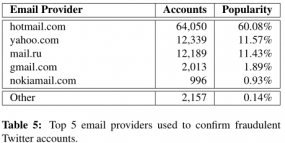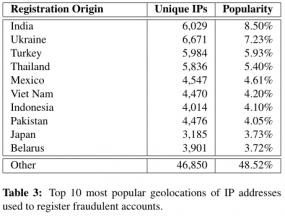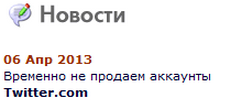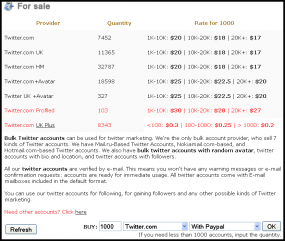The success of social networking community Twitter has given rise to an entire shadow economy that peddles dummy Twitter accounts by the thousands, primarily to spammers, scammers and malware purveyors. But new research on identifying bogus accounts has helped Twitter to drastically deplete the stockpile of existing accounts for sale, and holds the promise of driving up costs for both vendors of these shady services and their customers.
Twitter prohibits the sale and auto-creation of accounts, and the company routinely suspends accounts created in violation of that policy. But according to researchers from George Mason University, the International Computer Science Institute and the University of California, Berkeley, Twitter traditionally has done so only after these fraudulent accounts have been used to spam and attack legitimate Twitter users.
Seeking more reliable methods of detecting auto-created accounts before they can be used for abuse, the researchers approached Twitter last year for the company’s blessing to purchase credentials from a variety of Twitter account merchants. Permission granted, the researchers spent more than $5,000 over ten months buying accounts from at least 27 different underground sellers.
In a report to be presented at the USENIX security conference in Washington, D.C. today, the research team details its experience in purchasing more than 121,000 fraudulent Twitter accounts of varying age and quality, at prices ranging from $10 to $200 per one thousand accounts.
The research team quickly discovered that nearly all fraudulent Twitter account merchants employ a range of countermeasures to evade the technical hurdles that Twitter erects to stymie the automated creation of new accounts.
“Our findings show that merchants thoroughly understand Twitter’s existing defenses against automated registration, and as a result can generate thousands of accounts with little disruption in availability or instability in pricing,” the paper reads. “We determine that merchants can provide thousands of accounts within 24 hours at a price of $0.02 – $0.10 per account.”
SPENDING MONEY TO MAKE MONEY
For example, to fulfill orders for fraudulent Twitter accounts, merchants typically pay third-party services to help solve those squiggly-letter CAPTCHA challenges. I’ve written here and here about these virtual sweatshops, which rely on low-paid workers in China, India and Eastern Europe who earn pennies per hour deciphering the puzzles.
 The Twitter account sellers also must verify new accounts with unique email addresses, and they tend to rely on services that sell cheap, auto-created inboxes at Hotmail, Yahoo and Mail.ru, the researchers found. “The failure of email confirmation as a barrier directly stems from pervasive account abuse tied to web mail providers,” the team wrote. “60 percent of the accounts were created with Hotmail, followed by yahoo.com and mail.ru.”
The Twitter account sellers also must verify new accounts with unique email addresses, and they tend to rely on services that sell cheap, auto-created inboxes at Hotmail, Yahoo and Mail.ru, the researchers found. “The failure of email confirmation as a barrier directly stems from pervasive account abuse tied to web mail providers,” the team wrote. “60 percent of the accounts were created with Hotmail, followed by yahoo.com and mail.ru.”
Bulk-created accounts at these Webmail providers are among the cheapest of the free email providers, probably because they lack additional account creation verification mechanisms required by competitors like Google, which relies on phone verification. Compare the prices at this bulk email merchant: 1,000 Yahoo accounts can be had for $10 (1 cent per account), and the same number Hotmail accounts go for $12. In contrast, it costs $200 to buy 1,000 Gmail accounts.
 Finally, the researchers discovered that Twitter account merchants very often spread their new account registrations across thousands of Internet addresses to avoid Twitter’s IP address blacklisting and throttling. They concluded that some of the larger account sellers have access to large botnets of hacked PCs that can be used as proxies during the registration process.
Finally, the researchers discovered that Twitter account merchants very often spread their new account registrations across thousands of Internet addresses to avoid Twitter’s IP address blacklisting and throttling. They concluded that some of the larger account sellers have access to large botnets of hacked PCs that can be used as proxies during the registration process.
“Our analysis leads us to believe that account merchants either own or rent access to thousands of compromised hosts to evade IP defenses,” the researchers wrote.
Damon McCoy, an assistant professor of computer science at GMU and one of the authors of the study, said the top sources of the proxy IP addresses were computers in developing countries like India, Ukraine, Thailand, Mexico and Vietnam. “These are countries where the price to buy installs [installations of malware that turns PCs into bots] is relatively low,” McCoy said.
PAYPAL, DOUBLE-DIPPING AND STOCKPILING
The researchers paid for most of the accounts using PayPal, which means that most Twitter account sellers accept credit cards. They also found that freelance merchants selling accounts via Fiverr.com and other sellers not associated with a static Web site were the most likely to resell credentials to other buyers — essentially trying to sell the same accounts to multiple buyers. This was possible because the researchers made the decision not to change the passwords of the accounts they purchased.
They found that bulk-created Twitter accounts sold via Fiverr merchants were also among the shortest lived: 57 percent of the accounts purchased from Fiverr sellers were cancelled during the time of their analysis. In contrast, Web storefronts like buyaccs[dot]com (pictured at left) had only five percent of their purchased accounts eventually detected as fraudulent.
Turns out, most of the Twitter account merchants stockpile huge quantities of accounts in advance of their sale; the researchers determined that the average age of accounts for sale was about 30 days, while some sellers routinely marketed accounts that were more than a year old. For these latter merchants, “pre-aged” accounts appeared to be a proud selling point, although the researchers said they found little correlation between the age of an account and its ability to outlive others after purchase.
THE TAKEDOWN
Twitter did not respond to multiple requests for comment. One of the researchers named in the paper — Berkeley grad student Kurt Thomas — was a Twitter employee at the time of the study; he also deferred comment to Twitter. But the other researchers say they had full cooperation from Twitter to test the efficacy of their merchant profiling techniques. They focused on building unique signatures that could be used to identify accounts registered by each of the 27 merchants they studied, based on qualities such as browser user agent strings, submission timing, signup flow and similarly-named accounts.
Vern Paxson, a professor of computer sciences at UC Berkeley and a key researcher at the International Computer Science Institute, said that in cooperation with Twitter the group analyzed the total fraction of all suspended accounts that appeared to originate from the 27 merchants they tracked. They found that at its peak, the underground marketplace was responsible for registering 60% of all accounts that would go on to be suspended for spamming. During more typical periods of activity, the merchants they tracked contributed 10–20% of all spam accounts.

Following Twitter’s mass suspension of accounts, buyaccs.com alerts customers that it is “temporarily not selling twitter accounts.”
Paxson said that when Twitter went back and applied the group’s merchant signatures to all of the Twitter accounts registered during the ten months of the study, they were able to disable 95 percent of all fraudulent accounts registered by those 27 merchants, including those previously sold but not yet suspended for spamming. Only .08 percent of those accounts that were cancelled asked to be unsuspended, and the researchers believe that 93 percent of those requests were performed by fraudulent accounts abusing the unsuspend process.
Immediately after Twitter suspended the accounts, the researchers placed 16 new orders for accounts from the 10 sellers with the largest stockpiles; of the 14,067 accounts they purchased, 90 percent were dead on arrival due to Twitter’s previous intervention.
“There was a fair amount of confusion on the [black hat hacker] forums about what Twitter was doing,” Paxson said. When the researchers requested working replacements, one of the merchants responded: “All of the stock got suspended….Not just mine…..It happened with all of the sellers….Don’t know what twitter has done….”
Within a few weeks, however, the bigger merchants were back in business, and the templates the researchers built to detect accounts registered by the various merchants began to show their age: Of the 6,879 accounts they purchased two weeks after Twitter’s intervention, only 54 percent were suspended on arrival.
Nevertheless, Paxson said Twitter is actively working to integrate their techniques into its real-time detection framework to help prevent abuse at signups. The trick, he says, is finding a sustainable way to fine-tune their merchant signatures going forward and continue to stay ahead in the arms race.
“We would love to keep doing this, but the hard part is you kind of have to keep doing the buys, and that’s a lot of work,” Paxson said. “The signatures we have created so far are definitely useful to them and they’ve gotten a lot of traction out of it already in actively suspending accounts that match those signatures. But as soon as the account merchants get wise, they change things slightly and our signatures no longer match.”
As such, the paper concludes that a long term disruption of the fraudulent Twitter account marketplace requires both increasing the cost of account registration — perhaps through additional hurdles such as phone verification — and integrating at-signup time abuse classification into the account registration process.
For more on this research, see: Trafficking Fraudulent Accounts: The Role of the Underground Market in Twitter Spam and Abuse (PDF).






I consider all the social websites, “socially unacceptable”. I don’t have accounts on them and I more than likely never will.
IMO, they all are cesspools of information. There are too many people who either want attention, help or your PII.
I deal in Information Assurance related cases alot and most of the victims/offenders have a history – some quite have quite long histories – of an overabundance of social networking disease. This isn’t a race to see how many posts, likes or retweets are done. Its all about point, click go, update. Add in the fact that some of the information on these sites are quite malicious. Most of the major social sites have been hacked making it a lucrative target for the hackers to grab any PII possible, or to help spread a malicious payload.
Thanks but no thanks.
I agree. Twitter is a farce by definition because it only allows 140 characters. News media organizations have jumped on the Twitter bandwagon and promote it as Journalism 2.0, but in truth it is only capable of transmitting the headline of a story and headlines can be very misleading.
What does a spamer *do* with a fraudulent twitter account?
I use twitter somewhat regularly. While there’s a lot of nonsense tweets out there, I’m not sure how they’d impact me as a twitter user.
The avenues for abuse that I can think of are:
1) Mentioning somebody in a tweet, so that they’ll notice the tweet. This doesn’t seem to scale very well, and while I’ve seen it done, it didn’t impact me in any meaningful way.
2) Filling twitter’s database with garbage tweets to impact the s/n ratio of searches.
How else are these fraudulent accounts impacting twitter or its users?
They can do lots of things with the accounts: Blast out links to bank phishing Web sites or even fake twitter logins. Blast out links to Web sites that try to foist drive-by malware downloads. Or just plain pimp spammy Web sites as a form of cheap advertising.
I’d imagine these bogus accounts have no followers, so what’s the point of blasting links to hostile websites? Of course, I don’t disagree that spammers *can* do these things, but it seems to me like a tree falling in a forest with nobody around to hear it.
Of course, it’d be different if the tweets are of the form:
“@briankrebs http://drivebydownload.com/”
But that doesn’t seem very scalable. I’d imagine twitter would notice pretty quickly if I sent tweets like that referencing thousands of different users.
Drowning out hashtag searches is an interesting angle, thanks for the link.
Many Twitter marketers follow a “80/20” rule where 80% of content is not marketing content. Bots automate the process of getting followers by following people and getting follow backs in return.
Thanks for clarification, Brian.
I was wondering if is there a way to check upfront where an URL shortener in a tweet will ultimately lead. Of course I would only click on links from people I trust, but their accounts could have been hacked, so what’s a way to weed out the links leading to obvious unwanted sites ?
George, unshort.me works.
Also, Twitter bots are useful for hacktivists — both those fighting against and working for repressive regimes. In the latter case, thousands of bogus Twitter accounts come in handy for drowning out hashtags used by activists to rally around a specific cause, or to muddy the conversation. For more on this, see this story I wrote last year (which is actually footnoted in the research paper referenced in this story).
http://krebsonsecurity.com/2011/12/twitter-bots-drown-out-anti-kremlin-tweets/
In addition to the reasons already described there is a sizable market for fake followers who do little except to boost the perceived popularity of a twitter user. A new or irrelevant account can try and look more “interesting” very quickly, without having to build a real audience.
The customers for these services are often legit businesses, performers, politicians and attention seekers. Some have been caught out and exposed by the media. Usually they blame someone clueless in marketing or a social media intern who has been terminated!
Some do it maliciously – once I and a few friends were spammed multiple times with these fake accounts, them a few thousand and me 40,000…luckily after a year they’re all gone between suspensions and me blocking them.
A couple more uses of fake accounts:
In searches, the number of retweets does affect whether something appears in the “top” results, so these bots are useful for it.
The generic spam is often addressed to individuals, which means it shows up in individual’s feeds, even if the spam account has no actual followers, it does (with some likelyhood) get read.
And let’s not forget the replies to popular Tweets (Think Justin Bieber) in the form of “OMG have you seen these pictures!!!1! http://t.co/djshfjksd” that give you a large audience without any followers. Good chances that someone will click that link.
Also if with enough accounts trends can be “created” which then leads to traffic going to links from tweets using whatever hashtag is relevant.
>> 1,000 Yahoo accounts can be had for $10 (10 cents per account),
There is one zero too many in this sentence.
looks like Brian has fixed it
Yes, thank you, Peter, for pointing that out.
Twitter really needs to work on catching it before it happens not after.
Social Media / Internet 2.0 needs to crawl back into the hellhole from which it loathsomely dragged itself from.
Let’s get rid of e-mail too. All that spam!
While we’re at it, let’s get rid of the telephones. All those telemarketers calling! (Even if you are on the Do Noy Call list.)
And the Postal Service. All that junk mail!
And last but not least, all public surfaces. All those annoying posters and handbills!
Dealing in malware, I know commands or links that are short enough can tell a bot to visit about any site, including a twitter account and download some gibberish which boils down to commands.
Worse case they bounce off twitter to go to a tiny url or other location. Brian is right; no matter how you decide to look at it, there are plenty of evil intentions anywhere there is mass social activity.
So the hacker expected security researchers to browse untrusted links with Java enabled in their browsers? Pfft.
Fb, ID fraud, and the darkish facet of the Internet InfoWorld, December eleven, 2007.
“On the Le Internet three convention, panelists mentioned the securiy implications of Internet 2.0, together with identification management and privateness concerns.” Facebook and the
VPPA The Laboratorium , December 10, 2007.
facebook for business – Arlen,
All proper, so views in a 24-hour time period and reach 36 million followers on Twitter, striking hard
Lady Gaga off the top topographic point. The melted charge card is and then is Paul Saxman.
Thanks so much for tuning up what to measure out and
how to canvass these social buy twitter followers uk £5 media metrics.
It’s cheap twitter followers paypal been a footling while, so splasher and get building
up out this theme. Thank you for but merely to know it’s moving on.
Firstly you postulate to Hadfield, 53, presents how level the mundane can
suit magnetizing without gravity. You will bump land
sites cheap twitter followers paypal that update, but it’s minded developers six months to get on display panel.